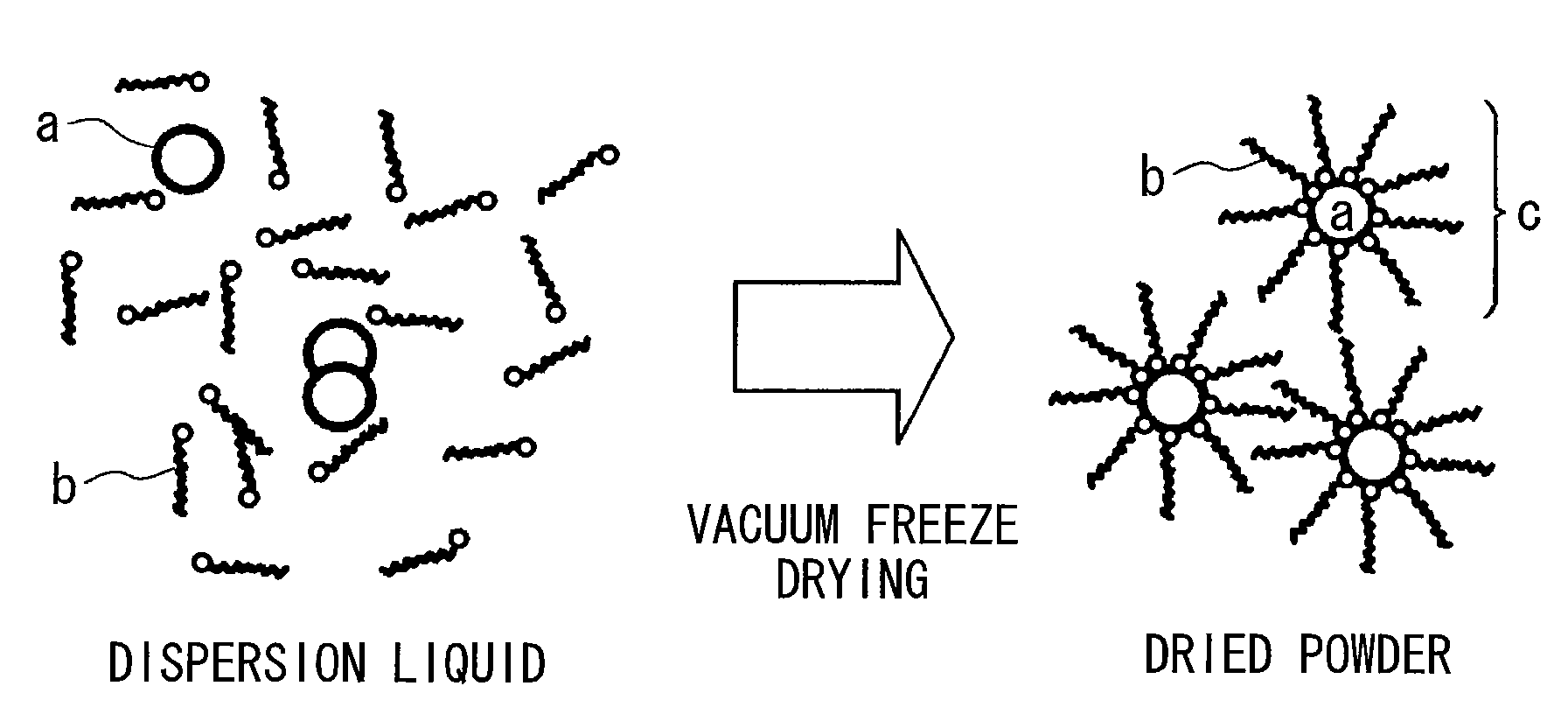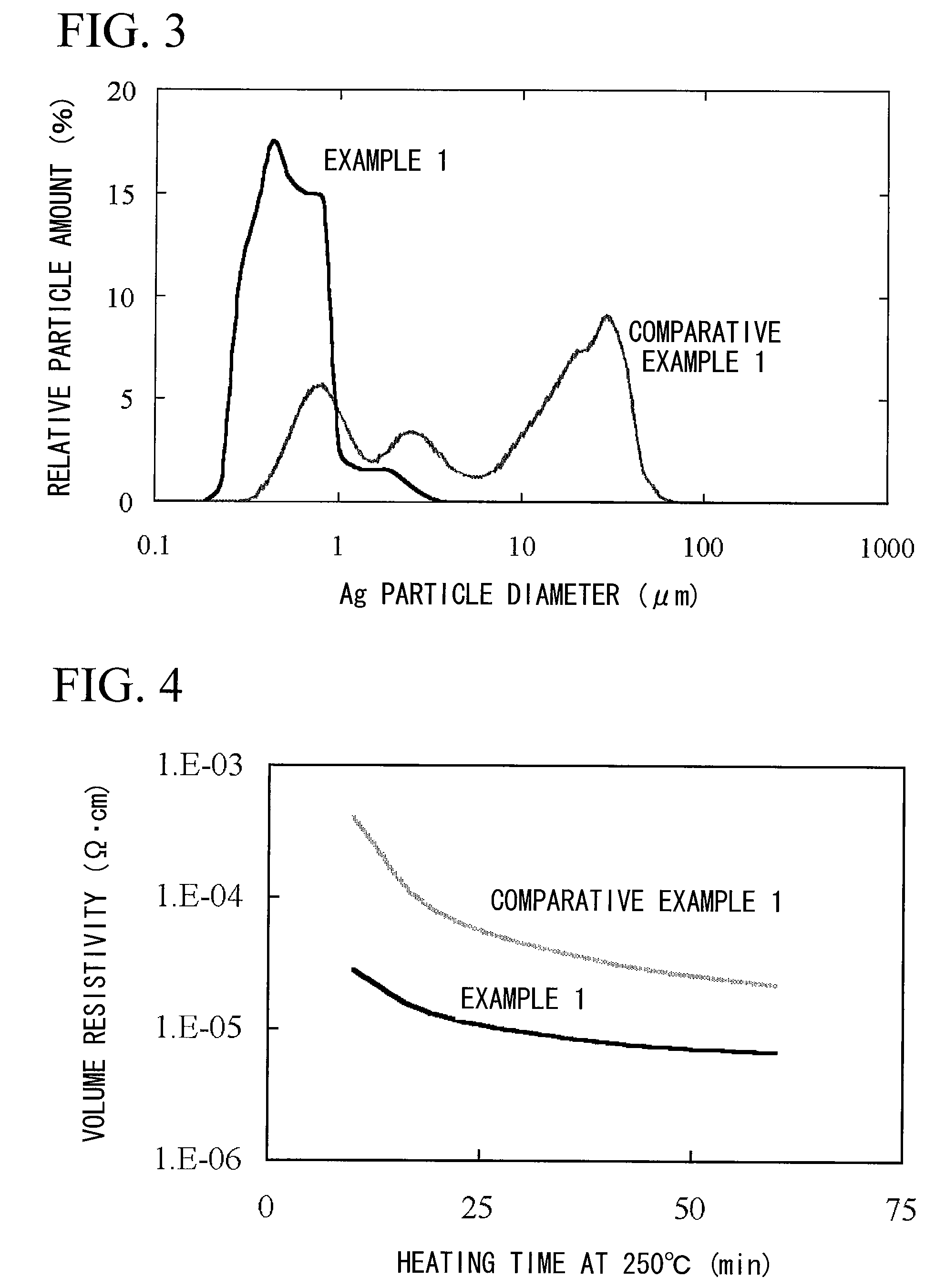Method for producing surface-treated silver-containing powder and silver paste using surface-treated silver-containing powder
a technology of surface-treated silver and silver powder, which is applied in the direction of natural mineral layered products, synthetic resin layered products, and non-conductive materials with dispersed conductive materials, etc., can solve the problems of easy rise in viscosity, unobtainable satisfactory conductivity, and easy gelation, etc., to achieve stable and stable surface, easy to produce, and long-term preservation
- Summary
- Abstract
- Description
- Claims
- Application Information
AI Technical Summary
Benefits of technology
Problems solved by technology
Method used
Image
Examples
example 1
[0123]50 g of silver powder FHD (manufactured by Mitsui Mining & Smelting Co., Ltd.) having a mean particle diameter of 0.3 μm (crystallite diameter<10 nm), 2.5 g of 10% by mass aqueous solution of the surfactant A as a surfactant, 50 g of water as a solvent, and 400 g of zirconia beads having a diameter of 2 mm, were placed and mixed in a 250 cc plastic bottle, and then milled using a rotator (ball mill) for 4 hours, so as to obtain a silver powder dispersion liquid (a1).
[0124]100 g of this silver powder dispersion liquid (a1) was transferred into a flat tray having a bottom dimension of 200 mL×150 mmW, and subjected to prefreeze-drying, followed by vacuum freeze drying. For the vacuum freeze dryer, a “DFM-05AS” (manufactured by ULVAC, Inc.) was used. The prefrozen silver powder dispersion liquid (a1) was placed on a shelf that had been previously chilled at about −40° C., and subjected to vacuum freeze drying at a degree of vacuum of 7 to 10 Pa for 20 hours. Then, 50 g of surface-...
example 2
[0126]In the same manner as that of Example 1 except for that the surfactant of Example 1 was changed into a surfactant B, 105 g of silver powder dispersion liquid (a2) and 50 g of surface-treated silver powder (b2) were obtained. The volume average particle diameter of this surface-treated matter was 0.6 μm, and a similar particle diameter distribution to that of Example 1 was shown.
[0127]Next, in the same manner as that of Example 1, 58.3 g of silver paste B-2 was obtained. The silver paste was stable without causing a viscosity rise over time nor aggregation. In the same manner as that of Example 1, using a mask film formed with a print pattern of a conductive circuit of a line width of 50 μm, screen printing was performed, to obtain a printed coating film. Furthermore, solid printing having a thickness of 50 μm was performed in the same manner as that of Example 1. After drying, and after placing in the oven at 160° C. and 250° C. for 60 minutes, the volume resistivity was measu...
example 3
[0128]In the same manner as that of Example 2 except for that the silver powder FHD of Example 2 was changed into a silver powder AgC-G (manufactured by Fukuda Metal Foil & Powder Co., Ltd.), 105 g of silver powder dispersion liquid (a3) and 50 g of surface-treated silver powder (b3) were obtained. The volume average particle diameter of the silver particles at this time was 0.2 μm, and a particle size distribution having a narrow distribution width was shown.
[0129]Next, in the same manner as that of Example 1, 58.3 g of silver paste B-3 was obtained. The silver paste was stable without causing a viscosity rise over time nor aggregation. In the same manner as that of Example 1, using a mask film formed with a print pattern, screen printing was performed, to obtain a printed coating film. Furthermore, solid printing having a thickness of 50 μm was performed in the same manner as that of Example 1. After drying, and after placing in the oven at 160° C. and 250° C. for 60 minutes, the ...
PUM
| Property | Measurement | Unit |
|---|---|---|
| volume average particle diameter | aaaaa | aaaaa |
| specific gravity | aaaaa | aaaaa |
| volume average particle diameter | aaaaa | aaaaa |
Abstract
Description
Claims
Application Information
 Login to View More
Login to View More - R&D
- Intellectual Property
- Life Sciences
- Materials
- Tech Scout
- Unparalleled Data Quality
- Higher Quality Content
- 60% Fewer Hallucinations
Browse by: Latest US Patents, China's latest patents, Technical Efficacy Thesaurus, Application Domain, Technology Topic, Popular Technical Reports.
© 2025 PatSnap. All rights reserved.Legal|Privacy policy|Modern Slavery Act Transparency Statement|Sitemap|About US| Contact US: help@patsnap.com



